From South Dakota we crossed through Wyoming on our way to Livingston, Montana. Along the way we stopped at Little Bighorn Battlefield.
The Battle of the Little Bighorn was fought along the ridges, steep bluffs, and ravines of the Little Bighorn River, in south-central Montana on June 25-26, 1876. The combatants were warriors of the Lakota Sioux, Northern Cheyenne, and Arapaho tribes, battling men of the 7th Regiment of the US Cavalry. The Battle of the Little Bighorn has come to symbolize the clash of two vastly dissimilar cultures: the buffalo/horse culture of the northern plains tribes, and the highly industrial/agricultural based culture of the United States. This battle was not an isolated soldier versus warrior confrontation, but part of a much larger strategic campaign designed to force the capitulation of the non-reservation Lakota and Cheyenne.
In 1868, many Lakota leaders agreed to sign the Treaty of Fort Laramie. This treaty created a large reservation in the western half of present-day South Dakota. The United States wanted tribes to give up their nomadic life which brought them into conflict with other Indians, white settlers and railroads.
Agreeing to the treaty meant accepting a more stationary life and relying on government-supplied subsidies. Lakota leaders such as Sitting Bull and Crazy Horse rejected the reservation system. Likewise, many roving bands of hunters and warriors did not sign the 1868 treaty. They felt no obligation to conform to its restrictions, or to limit their hunting only to the land assigned by the treaty.
Their forays off the set aside lands brought them into conflict with settlers and enemy tribes outside the treaty boundaries. Tension between the United States and the Lakota escalated in 1874, when Lt. Col. George Armstrong Custer was ordered to make an exploration of the Black Hills inside the boundary of the Great Sioux Reservation. Custer was to map the area, locate a suitable site for a future military post, and to make note of the natural resources.
During the expedition, professional geologists discovered deposits of gold. Word of the discovery of mineral wealth caused an invasion of miners and entrepreneurs to the Black Hills in direct violation of the treaty of 1868. The United States negotiated with the Lakota to purchase the Black Hills, but the offered price was rejected by the Lakota. The climax came in the winter of 1875, when the Commissioner of Indian Affairs issued an ultimatum requiring all Sioux to report to a reservation by January 31, 1876. The deadline came with virtually no response from the Indians, and matters were handed to the military.
The battle was a momentary victory for the Lakota and Cheyenne. The death of Custer and his troops became a rallying point for the United States to increase their efforts to force native peoples onto reservation lands. With more troops in the field, Lakota hunting grounds were invaded by powerful Army expeditionary forces determined to conquer the Northern Plains Indians. Most of the declared “hostiles” had surrendered within one year of the fight, and the Black Hills were taken by the US government without compensation.
Little Bighorn Battlefield National Monument preserves the site. It also serves as a memorial to those who fought in the battle: George Armstrong Custer’s 7th Cavalry and a combined Lakota-Northern Cheyenne and Arapaho force. Custer National Cemetery, on the battlefield, is part of the national monument. There are white tombstones scattered across the rolling foothills marking where lives were lost.

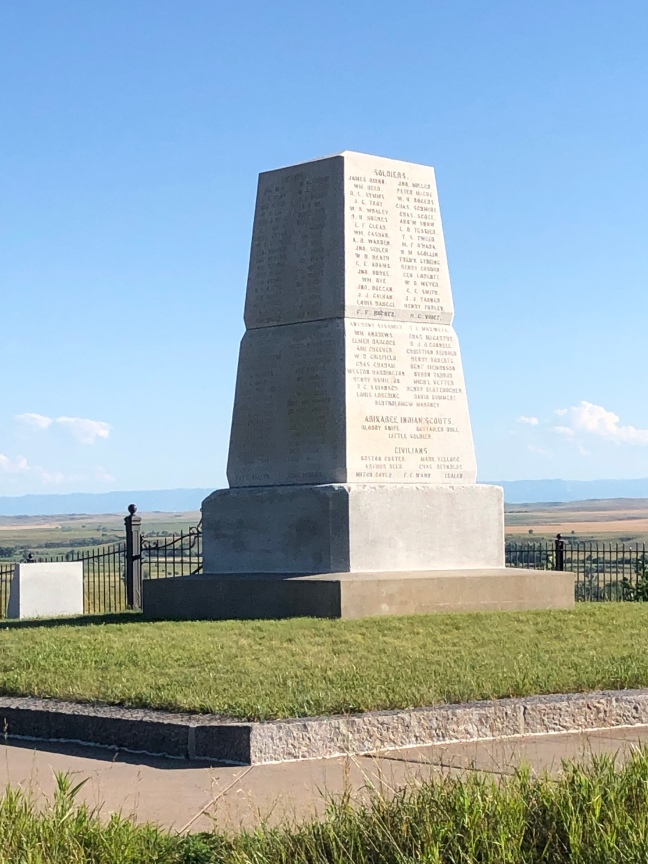 We parked the RV at the KOA between Livingston and Yellowstone National Park along the banks of the Yellowstone River. We also booked rooms at the Yellowstone Pioneer Lodge in Livingston. There is a variety of newer lodging closer to the park, mostly in the quaint western town of Gardiner with a population of 875 residents. These options book far in advance and there are many annual repeat guests. Another beautiful option for parking motor homes that had no vacancy is the Yellowstone’s Edge RV park, with camp sites along the riverbank. We rented SUV’s to drive through the park.
We parked the RV at the KOA between Livingston and Yellowstone National Park along the banks of the Yellowstone River. We also booked rooms at the Yellowstone Pioneer Lodge in Livingston. There is a variety of newer lodging closer to the park, mostly in the quaint western town of Gardiner with a population of 875 residents. These options book far in advance and there are many annual repeat guests. Another beautiful option for parking motor homes that had no vacancy is the Yellowstone’s Edge RV park, with camp sites along the riverbank. We rented SUV’s to drive through the park.
Dubbed “America’s Living Natural History Museum,” on March 1, 1872, Yellowstone became the first national park for all to enjoy the unique hydrothermal wonders. Greater Yellowstone’s diversity of natural wealth includes the hydrothermal features, wildlife, vegetation, lakes, and geologic wonders like the Grand Canyon of the Yellowstone River. The river snakes through the vast and varied terrain providing breathtaking vistas to have a picnic or simply admire the sunlight’s sparkling reflection on the rippling water with mountains in the distance.
We found ourselves oohing and aahing at the jaw-dropping geysers, hot springs, fumaroles, fountain paint pots and waterfalls. The fountain paint pots are bizarre ponds of boiling hot mud that causes bubbling at the surface. While it’s fascinating to stroll along the boardwalks above the boiling hot springs, it’s critical to take heed of the warnings. In thermal areas the ground may be only a thin crust above the scalding mud. There is no way to guess a safe path as new hazards can literally bubble up overnight, and some pools are acidic enough to burn through boots. More than a dozen people have been scalded to death and hundreds badly burned and scarred.
















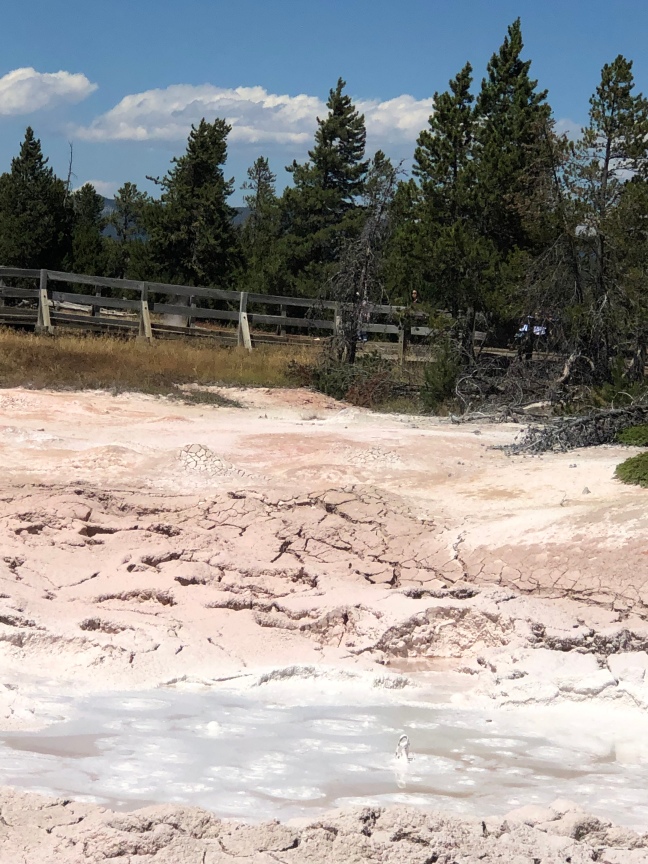
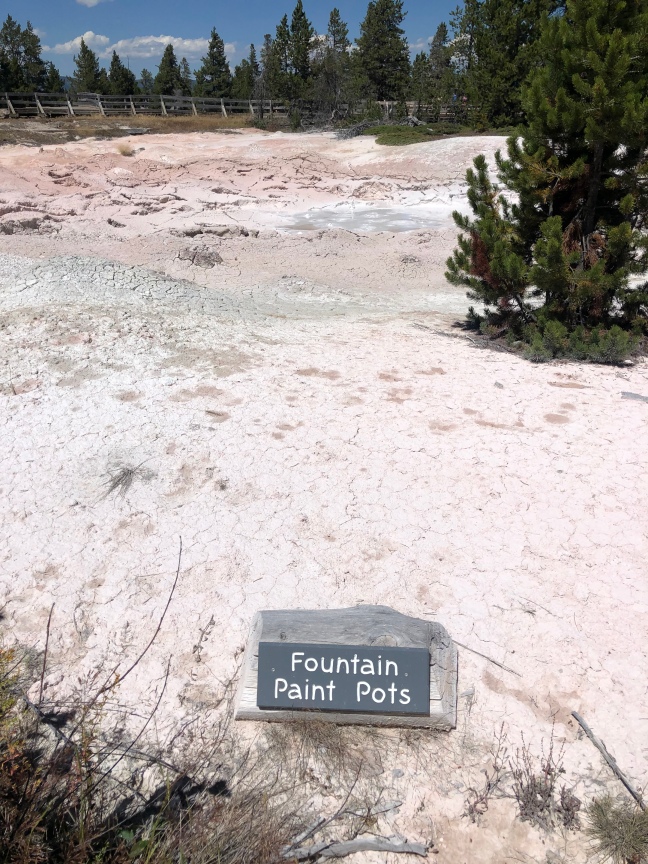
 We stood in the blazing hot afternoon sun as Old Faithful teased us before erupting into the sky where the steam generated by the explosion billowed into the air blending with ease into the cotton-like powdery white clouds that punctuated the bright blue skies. Discovered in 1870 by the Washburn Expedition, Old Faithful geyser was named for its frequent and somewhat predictable eruptions, which occur about every 90 minutes. After watching Mother Nature’s spectacular show, we had lunch at the cafeteria inside the lodge which also features a gift store and coffee shop.
We stood in the blazing hot afternoon sun as Old Faithful teased us before erupting into the sky where the steam generated by the explosion billowed into the air blending with ease into the cotton-like powdery white clouds that punctuated the bright blue skies. Discovered in 1870 by the Washburn Expedition, Old Faithful geyser was named for its frequent and somewhat predictable eruptions, which occur about every 90 minutes. After watching Mother Nature’s spectacular show, we had lunch at the cafeteria inside the lodge which also features a gift store and coffee shop.
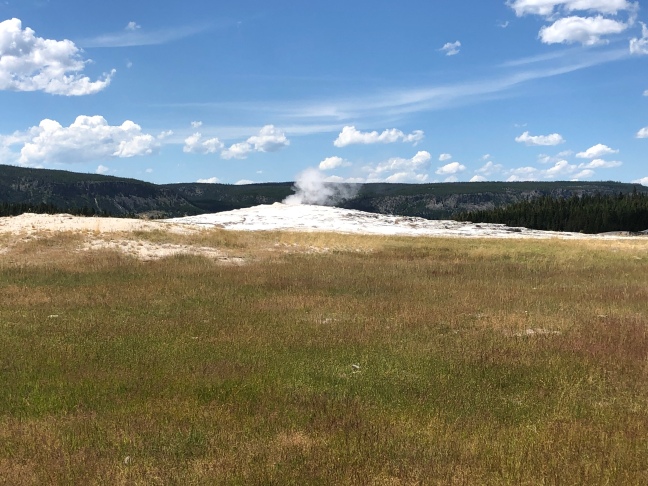


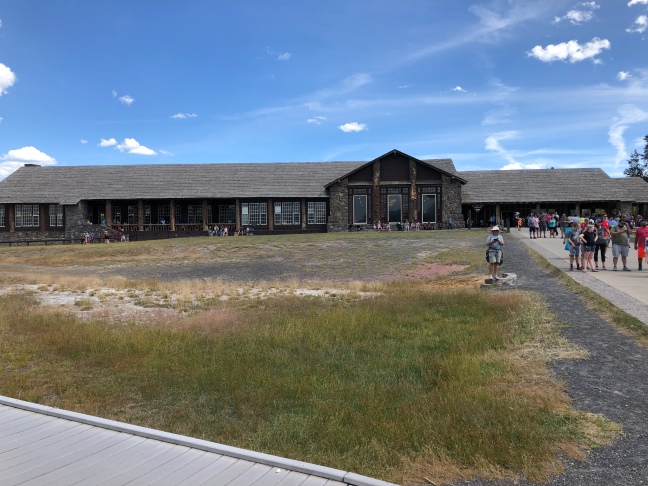 I had no idea that the Grand Canyon of the Yellowstone River existed. The canyon below the Lower Yellowstone Falls was at one time the site of a geyser basin that was the result of rhyolite lava flows, extensive faulting, and heat beneath the surface related to the hot spot. No one is sure exactly when the geyser basin was formed in the area, although it was probably present at the time of the last glaciation.
I had no idea that the Grand Canyon of the Yellowstone River existed. The canyon below the Lower Yellowstone Falls was at one time the site of a geyser basin that was the result of rhyolite lava flows, extensive faulting, and heat beneath the surface related to the hot spot. No one is sure exactly when the geyser basin was formed in the area, although it was probably present at the time of the last glaciation.
The chemical and heat action of the geyser basin caused the rhyolite rock to become hydrothermally altered, making it very soft and brittle and more easily erodible. Evidence of this thermal activity still exists in the canyon in the form of geysers and hot springs that are still active and visible. The Clear Lake area, which is fed by hot springs, south of the canyon is probably also a remnant of this activity.
When the ice dams melted, a great volume of water was released downstream causing massive flash floods and immediate and catastrophic erosion of the present-day canyon. These flash floods probably happened more than once. The canyon is a classic V-shaped valley, indicative of river-type erosion rather than glaciation. Today the canyon is still being eroded by the Yellowstone River.
The colors in the canyon are also a result of hydrothermal alteration. The rhyolite in the canyon contains a variety of different iron compounds. When the old geyser basin was active, the “cooking” of the rock caused chemical alterations in these iron compounds. Exposure to the elements caused the rocks to change colors. The rocks are oxidizing; in effect, the canyon is rusting. The colors indicate the presence or absence of water in the individual iron compounds. Most of the yellows in the canyon are the result of iron present in the rock rather than, as many people think, sulfur.




 As development spread across the West, the 2.2 million acres of habitat within the park became an important sanctuary for the largest concentration of wildlife in the lower 48 states. The abundance and distribution of these animal species depend on their interactions with each other and on the quality of their habitats, which in turn is the result of thousands of years of volcanic activity, forest fires, changes in climate, and more recent natural and human influences.
As development spread across the West, the 2.2 million acres of habitat within the park became an important sanctuary for the largest concentration of wildlife in the lower 48 states. The abundance and distribution of these animal species depend on their interactions with each other and on the quality of their habitats, which in turn is the result of thousands of years of volcanic activity, forest fires, changes in climate, and more recent natural and human influences.
Most of the park is above 7,500 feet in elevation and underlain by volcanic bedrock. The terrain is covered with snow for much of the year and supports forests dominated by lodgepole pine and interspersed with alpine meadows. Sagebrush steppe and grasslands on the park’s lower-elevation ranges provide essential winter forage for elk, bison, and bighorn sheep. Unfortunately, we were lamenting the absence of wildlife all day. in fact we’d only seen some eerie ravens. Just before we gave up hope, God smiled on us and some animals came out at dusk as we were leaving the park.
A white SUV coming toward us pulled to the side of the road and the occupants were pointing out the windows. They told us they’d spotted a black bear. Almost instantaneously all cars in both directions stopped and people took to the road by foot tripping over each other in order to see this bear having its dinner on the sagebrush whilst being camouflaged by a tree trunk and foliage.
About another ten miles down the road we came to a halt with excitement as an enormous black bear was at the edge of the road pacing in agitation. People were climbing out of their sunroofs to get photos. Next on the wildlife safari was a lone antelope in the tall grass taking a nap or perhaps on the hunt for his supper. Finally, we came upon herds of elk as we exited the park. Their babies make an excited, high-pitched squealing noise and one looked directly at us while doing a little comical jumping dance as our five-pound Yorkie Spike barked at the baby elk with equal enthusiasm.



 We stopped in Gardiner on our way out of Yellowstone. Quaint, Old West-style Gardiner sits on the north edge of Yellowstone, making it a convenient gateway town. It’s the only year-round entrance to the park. Pretty much everything in Gardiner is colorful from the scenery and people to the names of dishes on menus.
We stopped in Gardiner on our way out of Yellowstone. Quaint, Old West-style Gardiner sits on the north edge of Yellowstone, making it a convenient gateway town. It’s the only year-round entrance to the park. Pretty much everything in Gardiner is colorful from the scenery and people to the names of dishes on menus.
Even its town name has a curious story. It’s named after an early fur trapper named Johnson Gardner, who spent time in the area and had a reputation as an outlaw. But when the Langford-Washburn-Doan Expedition came through the area in 1870, making detailed maps and observations, they misspelled “Gardner,” adding an unnecessary “i.” The spelling stuck.
Most of Gardiner’s residents work for the park or in the tourism industry. And they all seem to share a great sense of pride in Gardiner’s rough-around-the-edges feel and the natural beauty surrounding it. Our friendly and attentive waitress at the Raven Grill was a prime example. A local who moved to Utah and has returned to work in her hometown for the summer, she shared with us that when other schools in the area would get only an inch of snow they would close. Not the case in Gardiner. She complained that she still had to go to school even when they had “several feet of snow.”
The Raven Grill is a neighborhood restaurant serving fresh regional food cooked over a wood fire grill and served in a casual, comfortable atmosphere. The menu blended local features like elk and bison with traditional items, including burgers and steaks. One of our favorites was the night’s featured penne pasta with sausage and goat cheese in a Madeira wine sauce.

 Montana is known as “Big Sky Country” and on the ride back to town after dinner we were treated to a sublime lighting show that illuminated the outline of the mountains in the otherwise pitch-black sky. Before hitting the road for the next destination, Glacier National Park, on our epic road trip through the North American Wild West, we fulfilled the lifelong wish of the family matriarch, Geri Yoder. Mama G commented that the river streaming through the park took her breath away. “I wish I was back in my 30’s and could run down and dip my toes in that river.” We found a spot with easy access to the water near the campground and she giggled with excitement as she stuck her feet in the Yellowstone River.
Montana is known as “Big Sky Country” and on the ride back to town after dinner we were treated to a sublime lighting show that illuminated the outline of the mountains in the otherwise pitch-black sky. Before hitting the road for the next destination, Glacier National Park, on our epic road trip through the North American Wild West, we fulfilled the lifelong wish of the family matriarch, Geri Yoder. Mama G commented that the river streaming through the park took her breath away. “I wish I was back in my 30’s and could run down and dip my toes in that river.” We found a spot with easy access to the water near the campground and she giggled with excitement as she stuck her feet in the Yellowstone River.
 Travel is about fulfilling dreams and making memories. The joy of shared experiences bonds a family together.
Travel is about fulfilling dreams and making memories. The joy of shared experiences bonds a family together.
 We parked the coach at the Greenwood Village Inn and Suites, which is a combination campground, mobile home park and hotel about 45 minutes outside of Glacier National Park. We rented a minivan to drive through the park, including the famous Going-to-the-Sun Road, and up into the Canadian Rockies.
We parked the coach at the Greenwood Village Inn and Suites, which is a combination campground, mobile home park and hotel about 45 minutes outside of Glacier National Park. We rented a minivan to drive through the park, including the famous Going-to-the-Sun Road, and up into the Canadian Rockies.





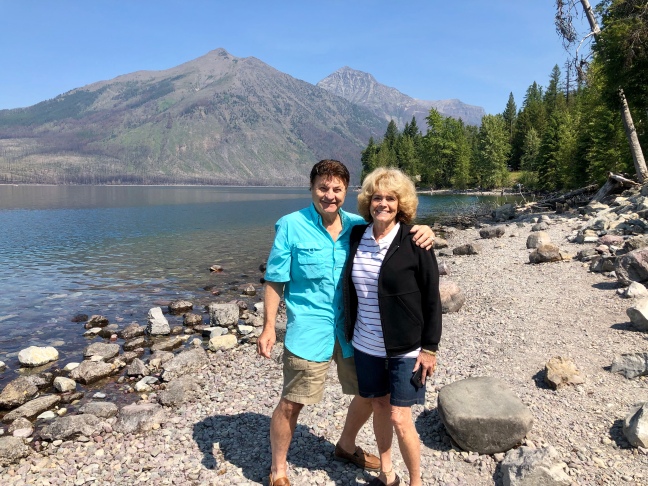





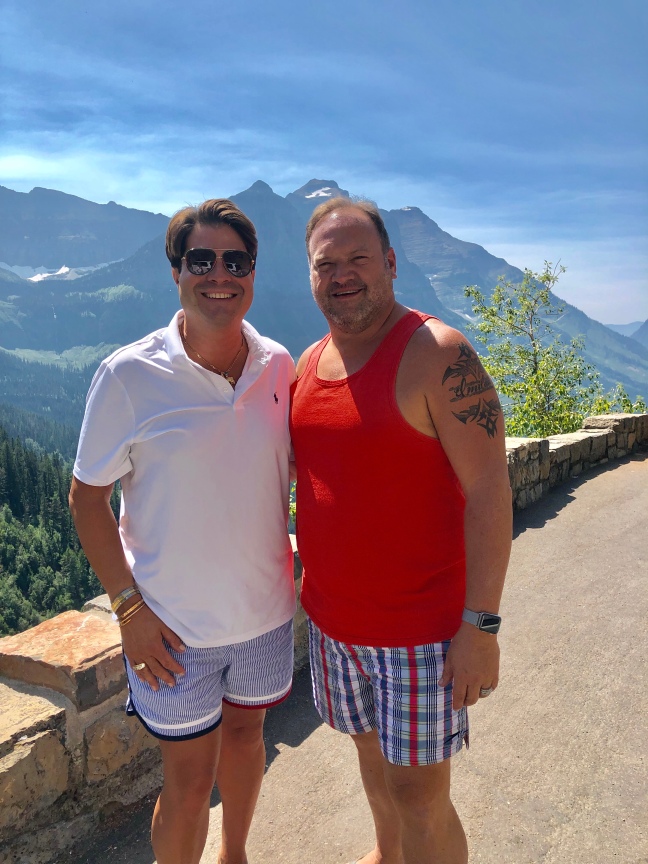
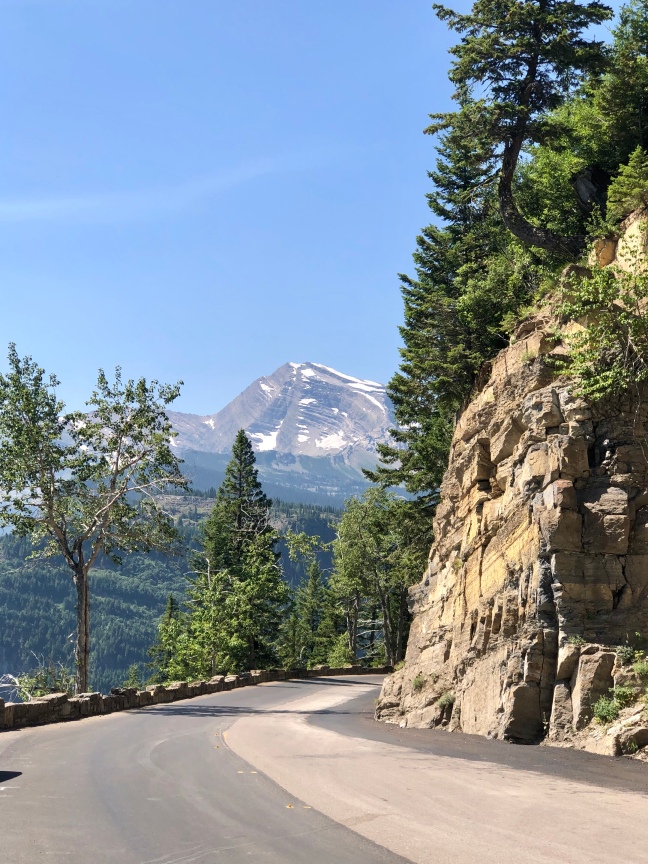
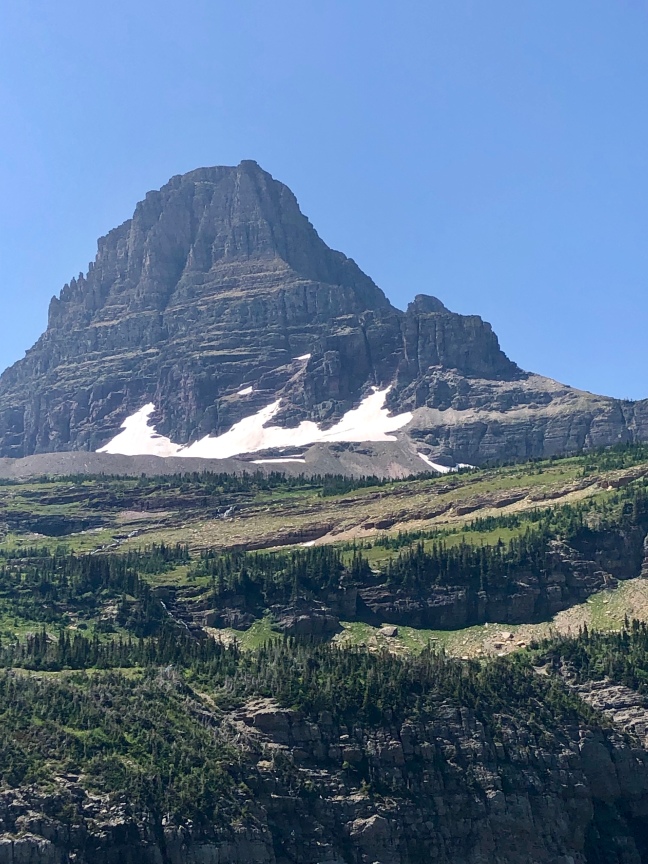







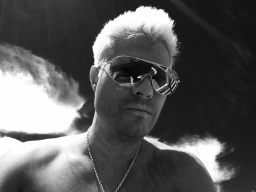

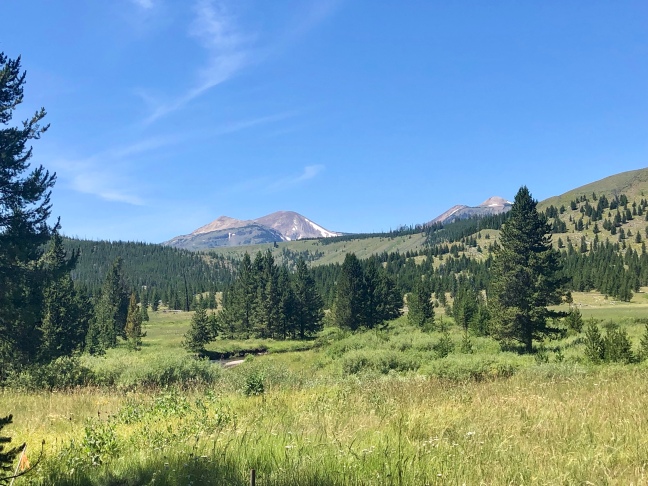

 We parked the RV at the KOA between Livingston and Yellowstone National Park along the banks of the Yellowstone River. We also booked rooms at the Yellowstone Pioneer Lodge in Livingston. There is a variety of newer lodging closer to the park, mostly in the quaint western town of Gardiner with a population of 875 residents. These options book far in advance and there are many annual repeat guests. Another beautiful option for parking motor homes that had no vacancy is the Yellowstone’s Edge RV park, with camp sites along the riverbank. We rented SUV’s to drive through the park.
We parked the RV at the KOA between Livingston and Yellowstone National Park along the banks of the Yellowstone River. We also booked rooms at the Yellowstone Pioneer Lodge in Livingston. There is a variety of newer lodging closer to the park, mostly in the quaint western town of Gardiner with a population of 875 residents. These options book far in advance and there are many annual repeat guests. Another beautiful option for parking motor homes that had no vacancy is the Yellowstone’s Edge RV park, with camp sites along the riverbank. We rented SUV’s to drive through the park.

















 We stood in the blazing hot afternoon sun as Old Faithful teased us before erupting into the sky where the steam generated by the explosion billowed into the air blending with ease into the cotton-like powdery white clouds that punctuated the bright blue skies. Discovered in 1870 by the Washburn Expedition, Old Faithful geyser was named for its frequent and somewhat predictable eruptions, which occur about every 90 minutes. After watching Mother Nature’s spectacular show, we had lunch at the cafeteria inside the lodge which also features a gift store and coffee shop.
We stood in the blazing hot afternoon sun as Old Faithful teased us before erupting into the sky where the steam generated by the explosion billowed into the air blending with ease into the cotton-like powdery white clouds that punctuated the bright blue skies. Discovered in 1870 by the Washburn Expedition, Old Faithful geyser was named for its frequent and somewhat predictable eruptions, which occur about every 90 minutes. After watching Mother Nature’s spectacular show, we had lunch at the cafeteria inside the lodge which also features a gift store and coffee shop.


 I had no idea that the Grand Canyon of the Yellowstone River existed. The canyon below the Lower Yellowstone Falls was at one time the site of a geyser basin that was the result of rhyolite lava flows, extensive faulting, and heat beneath the surface related to the hot spot. No one is sure exactly when the geyser basin was formed in the area, although it was probably present at the time of the last glaciation.
I had no idea that the Grand Canyon of the Yellowstone River existed. The canyon below the Lower Yellowstone Falls was at one time the site of a geyser basin that was the result of rhyolite lava flows, extensive faulting, and heat beneath the surface related to the hot spot. No one is sure exactly when the geyser basin was formed in the area, although it was probably present at the time of the last glaciation.



 As development spread across the West, the 2.2 million acres of habitat within the park became an important sanctuary for the largest concentration of wildlife in the lower 48 states. The abundance and distribution of these animal species depend on their interactions with each other and on the quality of their habitats, which in turn is the result of thousands of years of volcanic activity, forest fires, changes in climate, and more recent natural and human influences.
As development spread across the West, the 2.2 million acres of habitat within the park became an important sanctuary for the largest concentration of wildlife in the lower 48 states. The abundance and distribution of these animal species depend on their interactions with each other and on the quality of their habitats, which in turn is the result of thousands of years of volcanic activity, forest fires, changes in climate, and more recent natural and human influences.


 We stopped in Gardiner on our way out of Yellowstone. Quaint, Old West-style Gardiner sits on the north edge of Yellowstone, making it a convenient gateway town. It’s the only year-round entrance to the park. Pretty much everything in Gardiner is colorful from the scenery and people to the names of dishes on menus.
We stopped in Gardiner on our way out of Yellowstone. Quaint, Old West-style Gardiner sits on the north edge of Yellowstone, making it a convenient gateway town. It’s the only year-round entrance to the park. Pretty much everything in Gardiner is colorful from the scenery and people to the names of dishes on menus.
 Montana is known as “Big Sky Country” and on the ride back to town after dinner we were treated to a sublime lighting show that illuminated the outline of the mountains in the otherwise pitch-black sky. Before hitting the road for the next destination, Glacier National Park, on our epic road trip through the North American Wild West, we fulfilled the lifelong wish of the family matriarch, Geri Yoder. Mama G commented that the river streaming through the park took her breath away. “I wish I was back in my 30’s and could run down and dip my toes in that river.” We found a spot with easy access to the water near the campground and she giggled with excitement as she stuck her feet in the Yellowstone River.
Montana is known as “Big Sky Country” and on the ride back to town after dinner we were treated to a sublime lighting show that illuminated the outline of the mountains in the otherwise pitch-black sky. Before hitting the road for the next destination, Glacier National Park, on our epic road trip through the North American Wild West, we fulfilled the lifelong wish of the family matriarch, Geri Yoder. Mama G commented that the river streaming through the park took her breath away. “I wish I was back in my 30’s and could run down and dip my toes in that river.” We found a spot with easy access to the water near the campground and she giggled with excitement as she stuck her feet in the Yellowstone River. Travel is about fulfilling dreams and making memories. The joy of shared experiences bonds a family together.
Travel is about fulfilling dreams and making memories. The joy of shared experiences bonds a family together.

 Our first stop was the iconic Mount Rushmore. About a 20 minute drive from Rapid City, Mount Rushmore National Memorial is a massive sculpture carved into the Black Hills region of South Dakota. Completed in 1941 under the direction of Gutzon Borglum and his son Lincoln, the sculpture’s roughly 60-ft.-high granite faces depict U.S. Presidents George Washington, Thomas Jefferson, Theodore Roosevelt and Abraham Lincoln. The site also features a museum with interactive exhibits. Having seen the monument on everything from post cards to television and history books to cartoons, it was gratifying to behold in person. Sam’s Mom, Geri Yoder, whom we affectionately call “Mama G” remarked that it had such an impact on her that she would have been satisfied if the sojourn had ended there. However, there was so much more to explore.
Our first stop was the iconic Mount Rushmore. About a 20 minute drive from Rapid City, Mount Rushmore National Memorial is a massive sculpture carved into the Black Hills region of South Dakota. Completed in 1941 under the direction of Gutzon Borglum and his son Lincoln, the sculpture’s roughly 60-ft.-high granite faces depict U.S. Presidents George Washington, Thomas Jefferson, Theodore Roosevelt and Abraham Lincoln. The site also features a museum with interactive exhibits. Having seen the monument on everything from post cards to television and history books to cartoons, it was gratifying to behold in person. Sam’s Mom, Geri Yoder, whom we affectionately call “Mama G” remarked that it had such an impact on her that she would have been satisfied if the sojourn had ended there. However, there was so much more to explore.

 About 10-15 minutes down the road is Crazy Horse Memorial. Crazy Horse is the world’s largest mountain carving located in the Black Hills of South Dakota. It is considered The Eighth Wonder of the World in progress. The Mission of Crazy Horse Memorial Foundation is to protect and preserve the culture, tradition and living heritage of the North American Indians. Impressively, the site features a museum and university.
About 10-15 minutes down the road is Crazy Horse Memorial. Crazy Horse is the world’s largest mountain carving located in the Black Hills of South Dakota. It is considered The Eighth Wonder of the World in progress. The Mission of Crazy Horse Memorial Foundation is to protect and preserve the culture, tradition and living heritage of the North American Indians. Impressively, the site features a museum and university. We made our way along the breathtaking Needles Highway stopping for reflective photos at Sylvan Lake with its mammoth rock formations jutting up from the water like a movie set. This heavenly slice of Americana evoked patriotism and childhood memories. At one point, Sam started singing “Home on the Range” while driving the green hills and pastures of Custer Park before coming upon a heard of wild buffalo. This is, after all, where “the buffalo roam and the deer and the antelope play.” The giant creatures literally surrounded our vehicles and reminded my parents and I of being on safari in Africa, especially when we saw elongated, open-air Jeeps emblazoned with “Buffalo Safari” logos.
We made our way along the breathtaking Needles Highway stopping for reflective photos at Sylvan Lake with its mammoth rock formations jutting up from the water like a movie set. This heavenly slice of Americana evoked patriotism and childhood memories. At one point, Sam started singing “Home on the Range” while driving the green hills and pastures of Custer Park before coming upon a heard of wild buffalo. This is, after all, where “the buffalo roam and the deer and the antelope play.” The giant creatures literally surrounded our vehicles and reminded my parents and I of being on safari in Africa, especially when we saw elongated, open-air Jeeps emblazoned with “Buffalo Safari” logos.







 We drove to The Badlands taking in the countless billboards for Wall Drug Store along the way. The rugged beauty of the Badlands draws visitors from around the world. These striking geologic deposits contain one of the world’s richest fossil beds. Ancient mammals such as the rhino, horse, and saber-toothed cat once roamed here. The park’s 244,000 acres protect an expanse of mixed-grass prairie where bison, bighorn sheep, prairie dogs, and black-footed ferrets live today. The prairie dogs were especially entertaining as they jumped from hole to hole squeaking and squealing with delight. They reminded me of “Alvin and the Chipmunks” and even tough-guy Sam thought they were adorable. A herd of big horn sheep grazing and napping in tall, wild grass with the striped clay canyons and orange sunset in the backdrop was something you’d see on National Geographic Television.
We drove to The Badlands taking in the countless billboards for Wall Drug Store along the way. The rugged beauty of the Badlands draws visitors from around the world. These striking geologic deposits contain one of the world’s richest fossil beds. Ancient mammals such as the rhino, horse, and saber-toothed cat once roamed here. The park’s 244,000 acres protect an expanse of mixed-grass prairie where bison, bighorn sheep, prairie dogs, and black-footed ferrets live today. The prairie dogs were especially entertaining as they jumped from hole to hole squeaking and squealing with delight. They reminded me of “Alvin and the Chipmunks” and even tough-guy Sam thought they were adorable. A herd of big horn sheep grazing and napping in tall, wild grass with the striped clay canyons and orange sunset in the backdrop was something you’d see on National Geographic Television.









 Wall Drug Store, often called simply Wall Drug, is a tourist attraction located in the town of Wall, South Dakota. It is a cowboy-themed shopping mall consisting of a drug store, gift shop, restaurants and various other stores, as well as an art gallery and an 80-foot brontosaurus sculpture. Unlike a traditional shopping mall, all the stores at Wall Drug operate under a single entity instead of being individually run stores. The New York Times has described Wall Drug as “a sprawling tourist attraction of international renown [that] draws some two million annual visitors to a remote town.”
Wall Drug Store, often called simply Wall Drug, is a tourist attraction located in the town of Wall, South Dakota. It is a cowboy-themed shopping mall consisting of a drug store, gift shop, restaurants and various other stores, as well as an art gallery and an 80-foot brontosaurus sculpture. Unlike a traditional shopping mall, all the stores at Wall Drug operate under a single entity instead of being individually run stores. The New York Times has described Wall Drug as “a sprawling tourist attraction of international renown [that] draws some two million annual visitors to a remote town.”
 Steak was on the menu for both nights which is no surprise for the mostly meat-and-potato loving crowd visiting the middle of cowboy country. The night before I arrived the group enjoyed Dakota Steakhouse where my Dad devoured a 44-ounce ribeye. We had good burgers and hand cut fries in Keystone despite the annoying flies which are prevalent throughout South Dakota. Local beef production is the norm and Red Rock Restaurant was no exception though the undercooked steaks had to be sent back for more time on the grill. The last day in Sturgis we found Jambonz Grill and Pub featuring southern cooking from Louisiana roots. They even have Po Boys.
Steak was on the menu for both nights which is no surprise for the mostly meat-and-potato loving crowd visiting the middle of cowboy country. The night before I arrived the group enjoyed Dakota Steakhouse where my Dad devoured a 44-ounce ribeye. We had good burgers and hand cut fries in Keystone despite the annoying flies which are prevalent throughout South Dakota. Local beef production is the norm and Red Rock Restaurant was no exception though the undercooked steaks had to be sent back for more time on the grill. The last day in Sturgis we found Jambonz Grill and Pub featuring southern cooking from Louisiana roots. They even have Po Boys. The Sturgis Motorcycle Rally is held annually for 10 days starting the first Friday in August, which was the day we happened to be there. Even though it was only the first day, street fairs were already active and motorcycles lined the crowded streets. Young women in bikinis offered “bike washes.” The rally was begun in 1938 by a group of Indian Motorcycle riders and was originally held for stunts and races. Attendance has historically been around 500,000 people, and the event generates around $800 million in revenue for this tiny town.
The Sturgis Motorcycle Rally is held annually for 10 days starting the first Friday in August, which was the day we happened to be there. Even though it was only the first day, street fairs were already active and motorcycles lined the crowded streets. Young women in bikinis offered “bike washes.” The rally was begun in 1938 by a group of Indian Motorcycle riders and was originally held for stunts and races. Attendance has historically been around 500,000 people, and the event generates around $800 million in revenue for this tiny town.


 From Sturgis we ventured on to Deadwood. The discovery of gold in the southern Black Hills in 1874 set off one of the great gold rushes in America. In 1876, miners moved into the northern Black Hills. That’s where they came across a gulch full of dead trees and a creek full of gold and Deadwood was born.
From Sturgis we ventured on to Deadwood. The discovery of gold in the southern Black Hills in 1874 set off one of the great gold rushes in America. In 1876, miners moved into the northern Black Hills. That’s where they came across a gulch full of dead trees and a creek full of gold and Deadwood was born.
 South Dakota is a slice of Americana that is filled with history and natural wonders. Rapid city is a great home base from which to explore many of the attractions. Continuing on, we made our way through Wyoming and into Montana, headed for Livingston from which we would explore Yellowstone, the topic of my next blog.
South Dakota is a slice of Americana that is filled with history and natural wonders. Rapid city is a great home base from which to explore many of the attractions. Continuing on, we made our way through Wyoming and into Montana, headed for Livingston from which we would explore Yellowstone, the topic of my next blog.